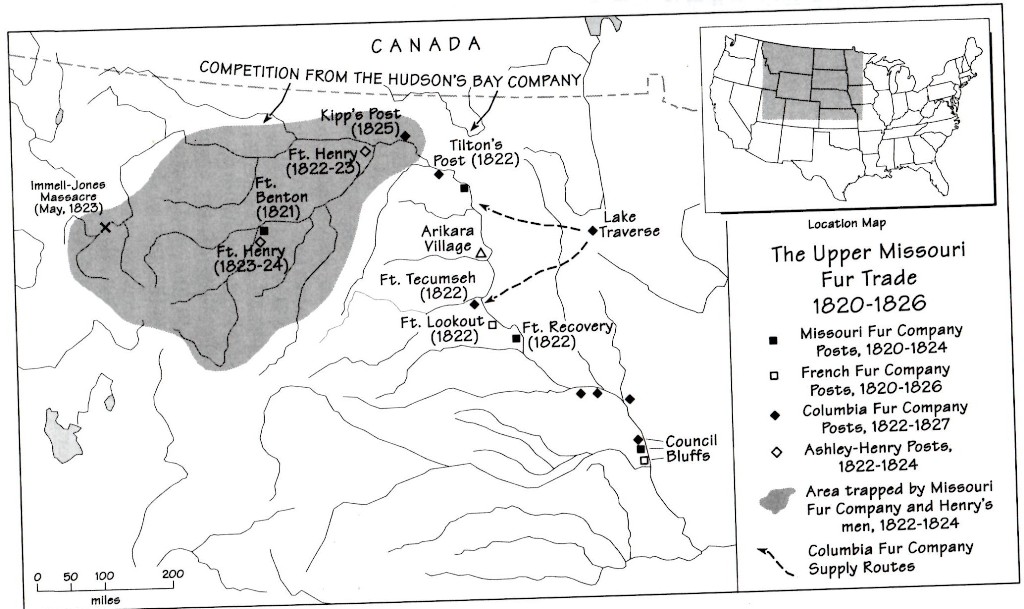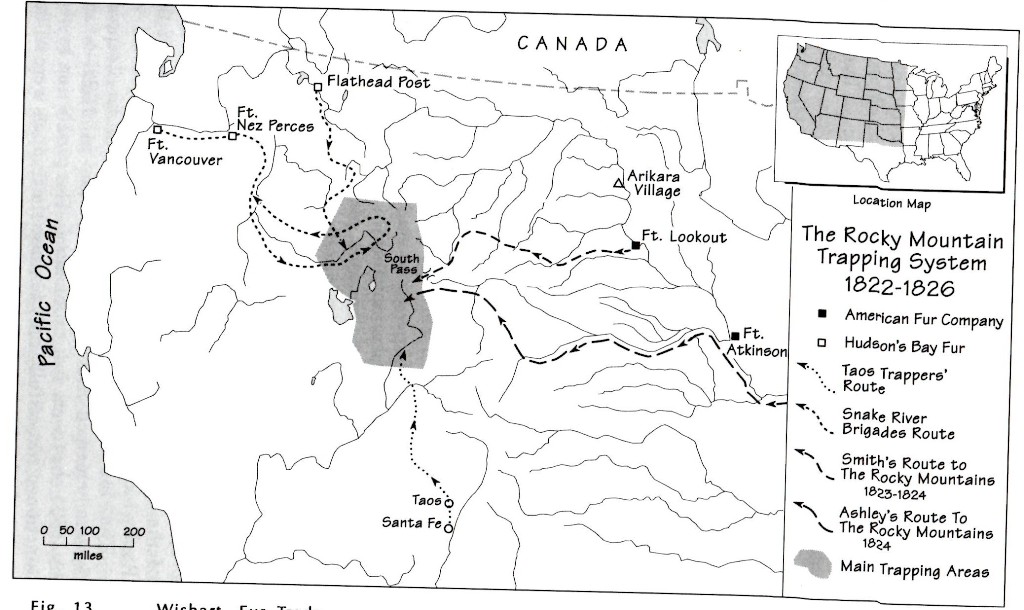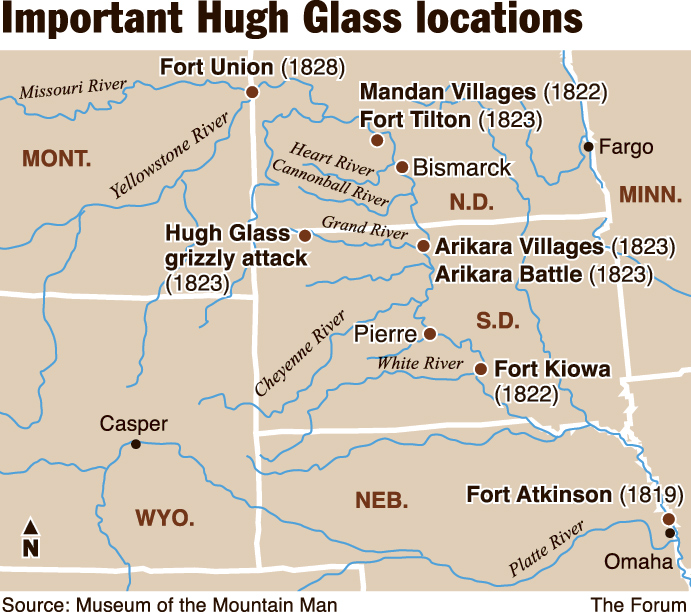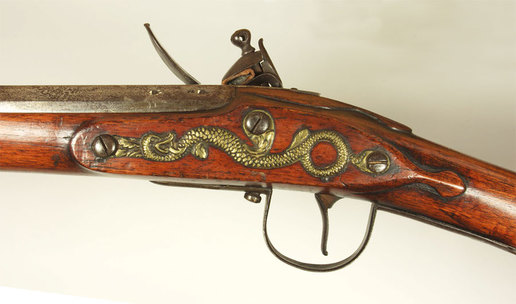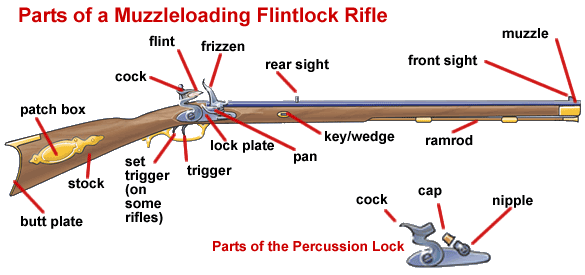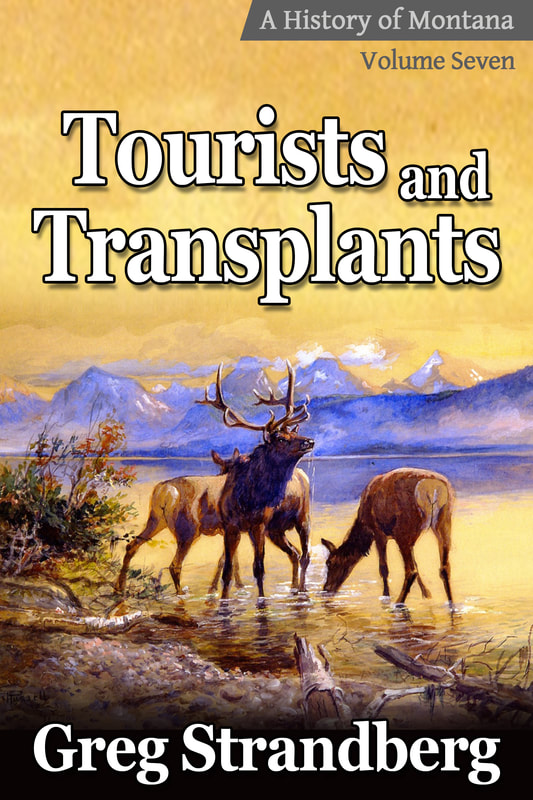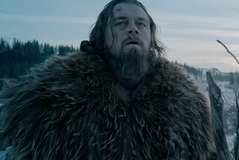
The movie came out on December 25 in America and made $155 million at the box office on a $135 million budget.
On top of that, it got 12 Academy Award nominations, the most of any film for the year.
Leonardo DiCaprio picked up the Best Actor Golden Globe for the film and is heavily favored to win the Best Actor Academy Award.
DiCaprio has been nominated 6 times for an Oscar: four times as Best Actor, once as Best Supporting Actor (What’s Eating Gilbert Grape), and once as producer (The Wolf of Wall Street).
Will this be his year?
I think so.
It might also be the year we see a revival of interest in the fur trade and America’s history in it.
And when it comes to that history, what are we to think of The Revenant?
Not much, as hardly anything in the film is historically accurate, at least story-wise.
The clothing, the locations, the view of the land, and what the men were doing out there…that’s all accurate.
The fate of the characters, however, couldn’t be further from the truth.
Let’s get into that today.
After you read this post you should have a very good picture of the Upper Missouri fur trade in America in the 1820s as well as what Hugh Glass was really like.
Timeline of Hugh Glass
This way we can know for sure what years the film The Revenant takes place in, and what really happened to Hugh Glass.
- On June 2, 1823, the Americans moving upriver with William Henry Ashley are attacked by the Arikara Indians, something that starts the Arikara War. Hugh Glass is with them.
- On August 10 Colonel Henry Leavenworth attacks the Arikara villages with 300 whites and 700 Sioux Indians. Arikara Chief Grey Eyes is killed (Elk Tongue would become the new chief). Hugh Glass takes a wound in the leg in this attack.
- On August 11 peace is made with the Indians and on August 14 the Arikara are allowed to abandon their villages.
- The men move upriver, staying in the general North Dakota region.
- It’s likely mid- to late-August by this point, and that’s when Hugh Glass is attacked by the grizzly.
- For ten days Hugh Glass lay beside the creek, likely taking us to the first few days of September. He was abandoned within the first three days.
- After ten days Glass begins walking, crawling, and dragging himself out of there. He finds a buffalo corpse to eat off of and for two days he stays put.
- He could have walked the whole way, perhaps starting with one mile, then five, before working his way up to ten each day. It’s likely getting into mid-September by this point.
- Another account has him being found by a group of Sioux Indians coming up the Missouri, who then took him to the fort. Whatever his pace or method, he made it, much to the surprise of everyone.
- Following Glass’s return to the fort, he rests up and then leaves Fort Kiowa for the Mandan Villages on October 10.
- He heads upriver with a group of men led by a man named Langevi and led by Touissant Charbonneau. Glass decides he’d like to save time by going overland. He does so, avoiding an attack by Indians that kills most of the men.
- After this Glass is walking to Tilton’s Fort which is nearby. Along the way, however, he runs into some Arikara and begins running. He catches sight of one to two Mandan Indians who take pity on him and ride him to Tilton’s Fort, which was owned by the Columbia Fur Company. Charbonneau was there, but no members of Langevin’s crew made it
- After a short stay at the Mandan Villages, Glass headed to the Yellowstone River and Fort Henry. It took him two weeks to get there, and he found the place abandoned. Overall, by the time he reaches Fort Henry again, it’d been 38 days since the grizzly bear attack. Some accounts having him reach Fort Henry at the end of December.
- Henry left a note as to where he was going, which was Fort Atkinson way down south. Glass winters at Fort Henry and then on February 24, 1824, he sets out for the Powder River. He ran into some Crow Indians, got some horses from them, and then ran into a group of mountain men, Jedediah Smith with them.
- By June Glass was at Fort Atkinson and learns that Fitzgerald was in town. By this point, however, Fitzgerald had joined up with the military and Glass couldn’t touch him.
- Glass heads to Santa Fe and the lucrative trade there. He disappears until 1830.
- Hugh Glass dies around Fort Cass on the Yellowstone River during the winter of 1832-3, killed by the Arikara.
The Trapping Party of Hugh Glass
One point is when the men are going to cache their furs after the attack on their fur camp by the Indians. Caches were quite common in the mountains, kind of like a modern day self-storage system.
What the mountain man couldn’t carry he cached. A cache was generally made on a rise where the soil was dry. The trappers dug a deep pit, lined it with sticks and leaves and carefully deposited their materials.
The pit was then filled over with soil and the surface of the ground restored to a natural condition in an effort to conceal the cache from Indians. This way things could be retrieved the next season when more men could help or more horses had been obtained. Perhaps some caches are still out there, never having been reclaimed.
Horses were another necessity of the mountain men, or if nowhere to be found, mules would suffice. The weight of a fur by itself was nothing, about 1.5 pounds or less, but when you factored in all the furs taken over a winter season or longer, it quickly added up, and such weight was unmanageable without an animal to carry the load.
One pack of furs was typically 80 to 100 furs pelts.
Hugh Glass’s Appearance
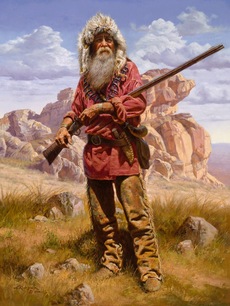
They often wore the furs they trapped and traveled light. Their gear often consisted of little more than a rifle with powder horns, various knifes.
Trapper’s equipment consists of his animal, a saddle and bridle, a sack with about six beaver traps, a blanket, an extra pair of Moccasins, his powder horn and bullet pouch.
There'd be a belt with a butcher knife, a small wooden box with bait for the beaver, a tobacco sack and a pipe, fire making tools, a hatchet, usually some coffee. They had basic cooking gear and simple foodstuffs.
Clothes consisted of flannel or cotton shirts, or maybe antelope skin if nothing else. A pair of leather breeches, leggings, a coat made of blanket or buffalo robe, a hat or wool cap, and for socks he used otter skin hose or buffalo or even pieces of blanket.
His bullet pouch, powder horn, and bullet-making tools were thrown over his shoulder in “possibles bags” which held other items like flints, pipes, tobacco, razors, and a container of bear-grease pomade to slick back his hair.
There was also the parfleche, which was similar to a suitcase or briefcase of today, and as made of rawhide and could carry dried meat and some extra clothes and moccasins.
Hugh Glass and Fort Kiowa
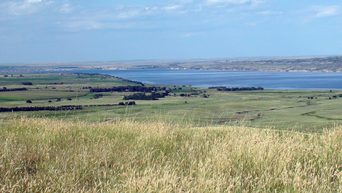 Location of Fort Kiowa
Location of Fort Kiowa
The fort is located by the modern day town of Chamberlain, South Dakota. It was built by Joseph Brazeau, Jr. in 1822 as a 140 square foot fort and lasted into the 1840s.
Brazeau was employed by Berthold, Chouteau, and Pratte, a leading trading company that’d survived the slow years of the War of 1812 and the economic depression that’d followed.
The fort had a blockhouse and a watchtower. The most pressing concern were attacks from Crow or Sioux Indians.
In 1827 Pratte bought Fort Kiowa from Brazeau and added a several four-room log houses, a new storehouse, and a smithy. A picket fence was put around the wall at a distance of thirty feet to dissuade attacks.
Later that year John Jacob Astor bought the fort from Pratte. Astor did well with his American Fur Company in the area, though by the 1830s the beaver had been trapped out, just at a time when demand for the fur was falling. Besides that, Indians were becoming increasingly hostile, both at the white’s presence and the over-trapping.
By 1840 the fort was bought by Joseph LeBarge, a former steamboat captain. The fort was turned into a post for Indian Agents but didn’t last the year.
Over the years the fort was flooded out completely due to the widening of the Missouri River.
Hugh Glass’s Rifle
The stock was made out of walnut wood, and featured a well defined comb and a narrow wrist as well as a brass patch box and brass furniture. She was 49 inches in length all told and could drop a good-sized buck at 100 yards. She was a killing machine, and the mountain men loved her.
There was also the trusty 1803 Harper’s Ferry Rifle, which was a ‘halfstock,’ so it was .54 caliber as well, a metal ramrod fitted on the side.
Many called the Kentucky Rifle a Kentucky Long Rifle. Some still called it a Pennsylvania, however, because that’s where they were made, if not used. It had a full stock, unlike the Harper’s Ferry, and a 44-inch barrel, giving it a caliber of .54 as well.
Next there was the Northwest Trade Gun, the typical weapon carried in abundance by the Hudson’s Bay Company personal in that area of the northwest. Besides its value out in the middle of nowhere as a trade good, it could use either ball or shot, making it an easy choice in a fast fight.
Just having a gun in the wilds didn’t mean you’d be alright. Typically a flintlock would fire seven out of ten times in dry weather, so you were already at a disadvantage.
Add in the snow and rain the mountain man knew the fire rate would go down closer to three out of ten, if even that. Keeping the flintlock dry was therefore critical, and often came down to how each particular gun was designed and subsequently maintained.
There was the flint itself, stuck into the upper jaw of the cock and held there by the flint screw. The cock screw was holding that to the lock plate, at the end of which was the powder pan and the frizzen and battery spring.
The whole area only took up a few inches worth of space on the side of and top of the musket, but it was the most important piece of the puzzle, for if it were out of sorts the gun simply would not fire.
Getting into the 1820s, many of the most notable mountain men used the Hawken rifle, the first of which was made for William H. Ashley in 1823.
Each rifle was built by hand individually, and ranged between .50 and .68 caliber. They weighed about 10 pounds and were quite accurate, even at long range.
What Hugh Glass Ate
Mountain men ate buffalo, elk, venison, lynx beaver tail, and mountain lion. They even ate lizards and snakes if they had to, and mules and horses would go if the need was great enough.
The buffalo was the main source of food, and mountain men, like Indians, used up most of it. They ate the hump rib, the tenderloins, the tongue, the heart, the testicles, called prairie oysters, and the marrow, which was referred to as trapper’s butter. They slit the buffalo’s jugular and drank the warm blood that dripped out, which many said tasted like milk.
They took the coiled intestines, our boudin, and squeezed them out and roasted them over the fire. They took the liver from the carcass and drizzled it with bile from the gall bladder so it would taste better.
The side of the animal’s spine held a strip of thick fat called the depouille, which they slathered in hot grease and smoked for a day to make tender and sweet, and better tasting than bread. The meat was boiled, roasted, or smoked and eaten right away or dried into jirk.
Roots and berries also supplemented the mountain man’s fare. Most carried pemmican, a lean meat from animals like bison or deer. It was dried over a fire or left out in the sun until it became hard, at which point it was pounded nearly into dust before being mixed with an equal amount of fat.
Conclusion
More than that, however, Fitzgerald never died. He never killed Andrew Henry, either, as is hinted at in the film.
Those are big things to some, small things to others.
Me personally, I don’t really care. The first time I saw a preview for The Revenant I knew I’d see it.
I write these kinds of books, after all, so it’s nice seeing what that stuff looks like on the big screen.
I encourage you to see this film on the big screen too.
The Revenant might not be historically accurate, but it’s damn entertaining.
You Might Also Like
Montana’s Mountain Men: Hugh Glass (a full biography)
Montana’s Mountain Men: Jim Bridger
Montana’s Mountain Men: Andrew Henry
Montana’s Mountain Men: William Henry Ashley
10 Great Mountain Man Fur Trapping Books
10 More Great Mountain Man Fur Trapping Books
5 Great Montana History Books
I Just Moved to Montana…What Books Should I Read?

